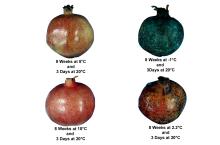Product Description
- External red color (depending on cultivar)
- Red color of juice (equal to or darker than Munsell color chart 5R-5/12)
- Acidity of juice below 1.85%
Maturity and Quality
- External red color (depending on cultivar)
- Red color of juice (equal to or darker than Munsell color chart 5R-5/12)
- Acidity of juice below 1.85%
- Freedom from growth cracks, cuts, bruises, and decay
- Skin color and smoothness
- Flavor depends on sugar/acid ratio which varies among cultivars. A soluble solids content above 17% is desirable
- Tannin content below 0.25% is desirable
Postharvest Handling and Storage
5°C (41°F) for up to 2 months; longer storage should be at 7.2°C (45°F) to avoid chilling injury.
| Temperature | 5°C (41°F) | 10°C (50°F) | 20°C (68°F) |
| ml CO2/kg·hr | 2-4 | 4-8 | 8-18 |
To calculate heat production multiply ml CO2/kg·hr by 440 to get Btu/ton/ day or by 122 to get kcal/metric ton/day.
Exposure to ethylene at 1 ppm or higher stimulates respiration and ethylene production rates, but it does not affect their quality attributes. Pomegranates do not ripen after harvest and must be picked fully ripe to ensure the best eating quality.
90-95%; pomegranates are very susceptible to water loss resulting in shriveling of the skins. Storing fruit in plastic liners and waxing can reduce water loss, especially under conditions of lower relative humidity.
Less than 0.1 µl/kg·hr at 10°C (50°F) or lower
Less than 0.2 µl/kg·hr at 20°C (68°F)
Very few studies of the responses of pomegranates to CA have been conducted. Storage in 2% O2 reduces chilling injury if pomegranates are kept below 5°C (41°F). In one study, pomegranates were stored successfully at 6°C (43°F) in 3% O2 + 6% CO2 atmosphere for 6 months. In another study a combination of 5% O2 + 15% CO2 was found to be effective in decay control and scald prevention for up to 5 months at 7°C (45°F).
Temperature & Controlled Atmosphere Photos

Title: CA Effects (1) Photo Credit: Don Edwards, UC Davis |

Title: CA Effects (2) Photo Credit: Don Edwards, UC Davis |
Disorders
Chilling Injury. External symptoms include brown discoloration of the skin and increased susceptibility to decay. Internal symptoms include a pale color of the arils (pulp around the seeds) and brown discoloration of the white segments separating the arils. Chilling injury occurs if pomegranates are exposed for longer than one month at temperatures between their freezing point -3°C (26.6°F) and 5°C (41°F) or longer than two months at 5°C (41°F).
Husk Scald. Brown discoloration of the husk (without any internal symptoms on the arils or surrounding tissues) that occurs during storage for more than 3 months at 7°C (45°F) or lower temperatures.
Gray mold. Caused by Botrytis cinerea, gray mold is the most important postharvest decay-causing fungus. Infection commonly begins in the orchard with spores of the fungus germinating and colonizing senescing blossom tissues in the calyx area. After harvest, the fungus grows into the pomegranate’s rind which turns light brown, tough, and leathery. This is followed by the appearance of gray mycelial growth at advanced stages of fruit decay. Minimizing physical damage of the calyx (crown) and fruit during harvest and postharvest handling, plus maintaining optimal temperature and relative humidity throughout postharvest handling of pomegranates are very important decay control strategies. Sanitation washes of fruit, however, may activate established infections in blossom tissues. Use of fludioxonil (Scholar) as a postharvest fungicide dip or drench is effective in controlling this fungus and is approved by USEPA with a maximum residue limit of 5 ppm. Carbon dioxide enriched atmospheres are fungistatic and cold temperatures also inhibit growth of Botrytis cinerea.
Heart Rot. This may be caused by Aspergillus spp., Alternaria alternata, and Alternaria arborescens. Affected fruit show a slightly abnormal skin color, and internally a mass of blackened arils. The disease develops while the fruit is on the tree. Affected pomegranates can be detected and removed by sorters in the packinghouse.











